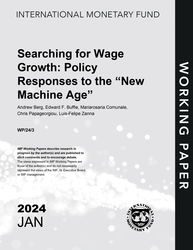
Searching for Wage Growth: Policy Responses to the “New Machine Age”
Searching for Wage Growth: Policy Responses to the “New Machine Age”
READ MORE...
Volume/Issue:
Volume 2024
Issue 003
Publication date: January 2024
ISBN: 9798400263682
$20.00
Add to Cart by clicking price of the language and format you'd like to purchase
Available Languages and Formats
| English |
Prices in red indicate formats that are not yet available but are forthcoming.
Topics covered in this book
This title contains information about the following subjects.
Click on a subject if you would like to see other titles with the same subjects.
Labor , Economics- Macroeconomics , Economics / General , Technological change , Artificial Intelligence , robots , growth , income distribution , fiscal policy , public investment , education , corporate tax tax cut , way policy , infrastructure investment , IMF working paper No , 2024/3 , ICT capital , Robotics , Skilled labor , Unskilled labor , Wages , Europe , Global
Summary
The current wave of technological revolution is changing the way policies work. This paper examines the growth and distributional implications of three policies when “robot'' capital (a broad definition of robots, Artificial Intelligence, computers, big data, digitalization, networks, sensors and servos) is introduced in a neoclassical growth model. 1) cuts to the corporate tax rate; 2) increases in education spending; and 3) increases in infrastructure investment. We find that incorporating “robot'' capital into the model does make a big difference to policy outcomes: the trickle-down effects of corporate tax cuts on unskilled wages are attenuated, and the advantages of investment in infrastructure, and especially in education, are bigger. Based on our calibrations grounded on new empirical estimates, infrastructure investment and corporate tax cuts dominate investment in education in a "traditional" economy. However, in an economy with “robots” the infrastructure investment dominates corporate tax cuts, while investment in education tends to produce the highest welfare gains of all. The specific results, of course, may depend on the exact modeling of the technological change, but our main results remain valid and can provide more accurate welfare rankings.
Copyright © 2010 - 2025
Powered by:
AIDC



